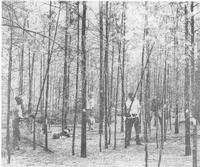


Chapter 4
I Management Of Native Forests
II Plantations-high Productivity Resources
III Protecting The Resource
IV Harvesting The Resource
V Solid Wood And Its Processing
VI Minor Forest Products
VII Reconstituted Wood Products
VIII Pulp And Paper
IX Export Woodchips
X Future Directions
XI Acknowledgements
References
Index
Search
Help
Contact us

An early export trade was also developed from Tasmania, two of the major species involved being Tasmanian blue gum (E. globulus) and Huon pine (Dacrydium franklinii), the latter also often being floated down rivers to the coast. Both were used extensively in shipbuilding as well as for other purposes. Jarrah (E. marginata) exports from Western Australia started in 1836, only seven years after the establishment of Perth. The initial shipment was sent to the naval dockyards in England but soon many other uses for this strong, durable and beautiful timber were developed. In 1845 export of Western Australian sandalwood (Santalum spicatum) to the Far East was begun and although small in tonnage became for a time that colony's major export income earner.[1]
By the middle of the 19th century almost all Australia's forests and woodlands had been discovered and many of their main species described. They were found to stretch -with an average width of some 300 km -from Tasmania and the south-east around the eastern coast more or less continuously to the northern-most point of the continent and then along the northern coast, petering out in the north-west but reappearing in a relatively small area of the south-west. It is probable that at the time of settlement forests covered some 9 per cent of the continent, about the twice the area remaining today.[2]
In NSW mixed eucalypt forests extended along the coastal areas both to the south and the north of Port Jackson. In the south the forests were mostly of the dry sclerophyll type, with the main species being spotted gum (E. maculata), silvertop ash (E. sieberi) and stringybarks (such as E. muellerana, E. obliqua and E. agglomerata). Blackbutt (E. pilularis), Sydney blue gum and turpentine (Syncarpia glomulifera) occurred in warm and humid environments both to the south and to the north and were joined in the latter region by flooded gum (E. grandis), tallowwood ( E. microcorys) and brush box (Tristania conferta). This same association, together with spotted gum, continued into south-eastern Queensland. Interspersed throughout the coastal eucalypt forests were pockets of sub-tropical and warm temperate rain forest, in the more fertile areas of which were valuable timbers such as red cedar, black bean (Castanospermum australe) and white beech (Gmelina leichhardtii). Further north in Queensland were the tropical rain forests containing other species such as Queensland maple (Flindersia brayleyana), maple silkwood (F. pimenteliana), Queensland silver ash (F. bourjotiana) and northern silky oak (Cardwellia sublimis). In some of the rain forests of northern NSW and Queensland also occurred Australia's most important native soft-wood, hoop pine (Araucaria cunninghamii) along with bunya pine (A. bidwillii) and kauri (Agathis robusta). Further inland in drier areas of south-eastern Queensland and northern NSW were large cypress pine (Callitris spp.) forests.

 |
Australian Academy of Technological Sciences and Engineering |  |
© 1988 Print Edition page 194, Online Edition 2000
Published by Australian Science and Technology Heritage Centre, using the Web Academic Resource Publisher
http://www.austehc.unimelb.edu.au/tia/204.html